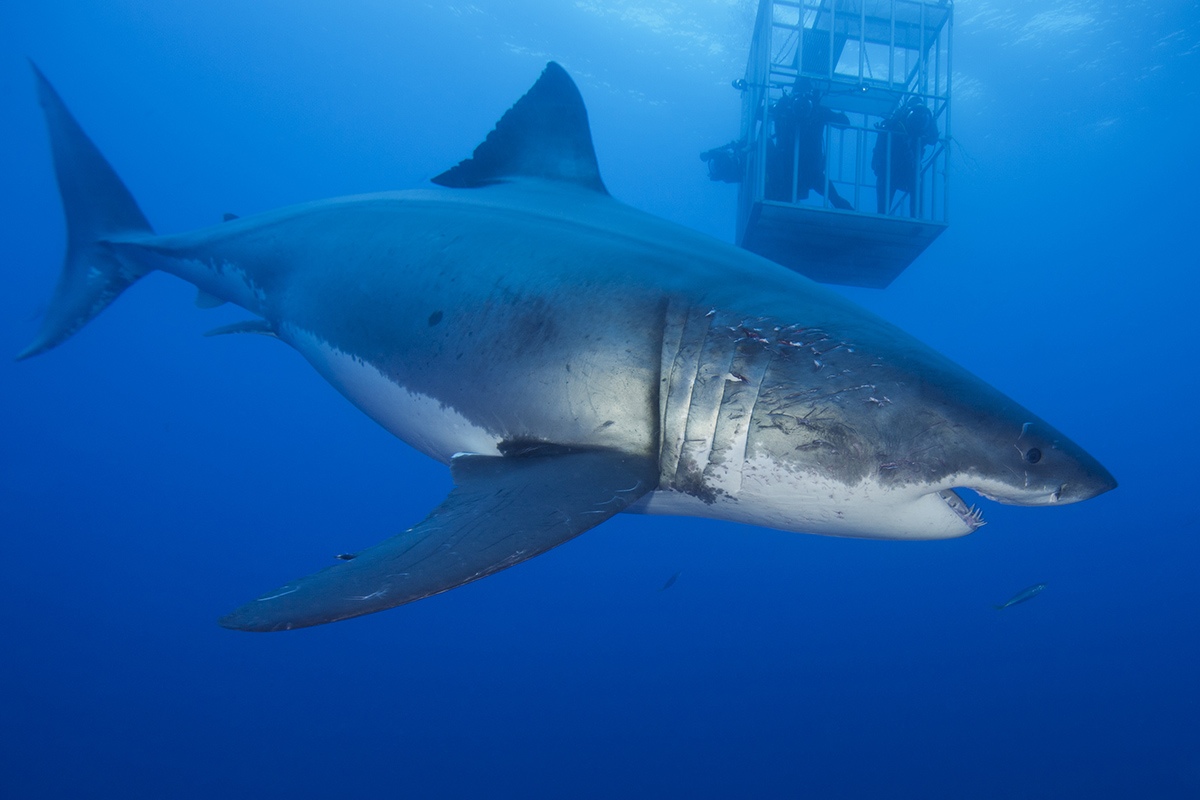Great White Shark High 5? Here's What Really Happened
One of the biggest great white sharks ever recorded has sent waves across the Internet not just for her plus size, but for what seemed to be a high five with a dive master hanging out in a shark cage.
Since the toothy gal, of course, was not privy to humans' celebratory hand gesture, what was she doing with her fin? Turns out, Joel Ibarra, the dive master of an ecotourism boat, was trying to keep the 22-foot-long (6.5 meters) great white shark, nicknamed Deep Blue, from harm.
"The dive master was pushing the shark away — it has a big laceration on the right side," said shark researcher Mauricio Hoyos Padilla, director of Pelagios-Kakunjá A.C., a nonprofit organization that focuses on sharks and other open-water species. "It was really close to the cage, and they have pointy ends. It is so big it couldn't turn properly. So he was trying to push her away, because he didn't want her to get hurt," Hoyos Padilla told Live Science. [See Stunning Images of Great White Sharks]
How did Hoyos Padilla come upon the giant shark? He has been studying sharks off Guadalupe Island, off the coast of Mexico, for about 13 years. The island is known as a great white shark breeding ground in the Pacific Ocean. Hoyos Padilla had a new hypothesis that the pregnant females would wait for elephant seals to arrive in the waters there in November and December, so the sharks could ambush the seals for sustenance. He found the female sharks could ambush the seals at a depth of 330 feet (100 meters). For his study he needed to observe pregnant female sharks, so he asked operators of ecotourism boats in the area to keep an eye out and contact him if they spotted one. Sure enough, a friend and dive master contacted him with Deep Blue's whereabouts.
During the outing, Hoyos Padilla and his team, including scientists from Woods Hole Oceanographic Institution in Massachusetts, garnered amazing footage of Deep Blue for one of the Discovery Channel's "Shark Week" shows last year. Once they encountered Deep Blue, the scientists tagged her with a transponder that emitted acoustic signals. An autonomous underwater vehicle (AUV) equipped with several cameras picked up those signals and followed the shark to record her movements and other data. That day, the AUV followed Deep Blue for more than 3 hours, Hoyos Padilla said.
The shark's expanded belly was a telltale sign she was pregnant. And she was big. Hoyos Padilla's boat is about 6.5 meters (22 feet) long, and Deep Blue looked longer than the boat, he said. Her size indicates she is likely more than 50 years old, he said. The oldest great white shark (Carcharodon carcharias) ever recorded by scientists was a 73-year-old male, with a length of 16.2 feet (4.93 meters) from snout to tail tip, according to a study published last year in the journal PLOS ONE.
The International Union for the Conservation of Nature (IUCN) considers great white sharks — which live in the coastal waters of all major oceans — vulnerable, meaning the species faces a high risk of extinction in the wild. Threats to the species include commercial and sport fishing, habitat degradation, campaigns to kill individuals involved in attacks and other factors, according to the IUCN.
Get the world’s most fascinating discoveries delivered straight to your inbox.
Sharks like great whites may seem fierce, but humans are more dangerous to them than they are to humans. Worldwide, there were 72 unprovoked shark attacks on humans in 2014, with three resulting in human deaths, according to the International Shark Attack File, compiled by biologists at the University of Florida. For comparison, humans killed 100 million sharks in 2000 and 97 million in 2010, researchers reported in 2013 in the journal Marine Policy.
Follow Jeanna Bryner on Twitter and Google+. Follow us @livescience, Facebook & Google+. Original article on Live Science.
Jeanna Bryner is managing editor of Scientific American. Previously she was editor in chief of Live Science and, prior to that, an editor at Scholastic's Science World magazine. Bryner has an English degree from Salisbury University, a master's degree in biogeochemistry and environmental sciences from the University of Maryland and a graduate science journalism degree from New York University. She has worked as a biologist in Florida, where she monitored wetlands and did field surveys for endangered species, including the gorgeous Florida Scrub Jay. She also received an ocean sciences journalism fellowship from the Woods Hole Oceanographic Institution. She is a firm believer that science is for everyone and that just about everything can be viewed through the lens of science.



